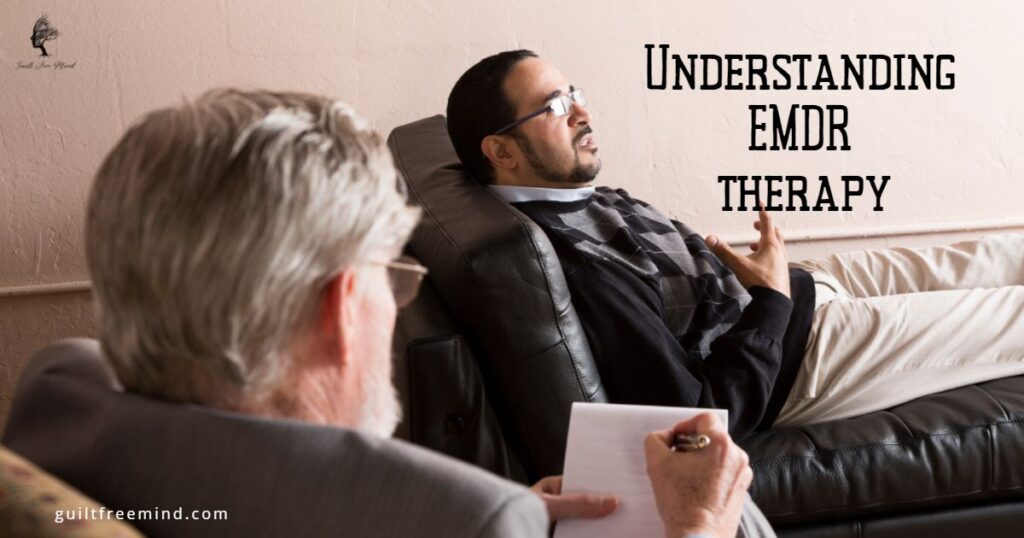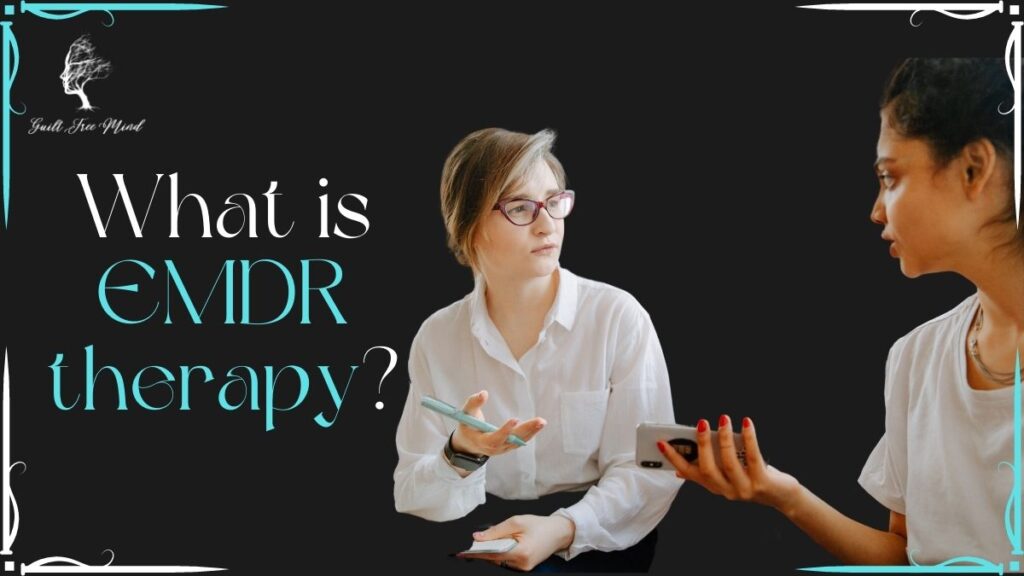Do you want to know about EMDR therapy? If you have a history of past trauma and have visited a mental health professional, you must have at least heard of the EMDR therapy. If you haven’t, fear not. In this article, I will discuss everything you need to know about EMDR therapy in the simplest language possible.
So far, in Guilt Free Mind, I have discussed topics that most people do not wish to talk about. Topics like emotional abuse, toxic relationship, commitment issues, psychopaths, and their symptoms are not discussed by people in random conversations, and neither are the therapeutic options that can help one recover.
Related articles:
9 tips for healing from emotional abuse
Leave a toxic relationship: 13 steps
Table of Contents
EMDR therapy
The primary focus of EMDR (Eye Movement Desensitization and Reprocessing) therapy is to help you heal and deal with past trauma. Sometimes specific incidences or triggers do not play a role in bringing up the past. Even unrelated things can trigger painful memories. You may feel overwhelmed or stuck in a loop of the past. EMDR therapy can help you overcome that.

How does trauma affect a person?
A traumatic event can easily drudge up painful memories. The thoughts, emotions, and images do not leave you. The physical scars of the trauma may go or fade with time. However, the emotional scars from the trauma are permanent.
People are stuck in the past because they are afraid that history might repeat itself. Thus, they try to stay hypervigilant about everything. They aim to prevent what happened in the past from recurring. However, they land up comparing every instance and scenario from their present with incidences from their past. Anything that remotely resembles their traumatic experience brings back negative thoughts. The person feels that the incident from the past is going to happen again.
As you must have guessed by now, in this article, I am going to discuss EMDR therapy. This is one of the therapeutic methods that has seen a high success rate in helping people overcome past trauma. Before I discuss how EMDR therapy can help patients with a history of past trauma, you need to understand EMDR therapy itself.
Related posts:
Art therapy can help deal with PTSD
What is EMDR therapy?
EMDR therapy uses a method of bilateral stimulation to promote healing in patients with a history of past trauma. EMDR therapy focuses on reconnecting the dots in the neural network of the patient. This allows the patient to understand and process that the trauma is a thing of the past and will not affect their present or future.
The focus of the EMDR therapy
The primary focus of EMDR therapy is to allow people to recover from the emotional distress and the symptoms that have stayed back due to their previous traumatic experiences. There have been many studies and surveys conducted on the efficiency of EMDR therapy. So far, it has been observed that the healing brought on by years of psychotherapy can be brought on much quicker by EMDR therapy.
It is commonly and rightfully concluded that emotional pain takes long to heal. Physical pains heal much faster than emotional ones. However, physical trauma can also take a long while to heal.
Understanding EMDR therapy
Let’s assume that you injured your leg while playing. You have an open gashing wound on your leg now. You remove the debris, clean the wound, apply antiseptic and allow the healing process to begin. Any normal person would expect the wound to heal in a matter of a week or two. However, if you get hurt in that same region before the healing of the wound, the pain will come back, and the recovery will get backtracked. Thus, it will take longer for the same wound to heal now. Again, you will clean the wound, apply antiseptic, take medicines and allow the wound to heal. The body will start to work on the healing mechanism again.

Emotional healing is similar
You should look at emotional healing in a similar light. Emotional trauma is deep-rooted and difficult to overcome because it is an injury that has been inflicted on you repeatedly. It was not one sarcastic remark or one shadowy comment that sent you into trauma. It was years of abuse. Therefore, the wound has festered to the point of becoming toxic.
When a patient goes for EMDR therapy, the psychotherapist aims to remove the imbalance that the repeated occurrence of disturbing events has caused. Once the therapist removes the block that is stopping the healing process, the healing of the past trauma starts automatically.
EMDR therapy employs detailed procedures and protocols that the clinicians learn during the training sessions to help their patients reactivate the healing process of the mind.
Positive outcomes
So far, EMDR therapy has shown over 30 outcomes that have resulted in emotional wellness and the betterment of the patient’s mental health. Some of the studies conducted on EMDR therapy have also shown that over 80% to 90% of victims with single trauma no longer suffered from their post-traumatic stress disorder after three sessions, each of 90 minutes.
Another study has shown that 100% of the patients who had single trauma and over 70% of the victims who had multiple traumas did not show signs or symptoms of PTSD after six therapy sessions or 50 minutes each.
As per the World Health Organization [WHO], the American Psychiatric Association, and the Department of Defense, EMDR therapy has now been recognized as an effective treatment form for patients suffering from past trauma.
How is EMDR therapy conducted?
EMDR therapy is an eight-phase treatment. The therapist will first identify which memory he wishes to target first. Bilateral stimulation or eye movements make up one part of the EMDR therapy session.
Once finalization of the memory happens, the therapist will ask the patient to hold the different aspects of the specific memory in his mind. The patient will have visions of that memory coming in and out of focus in his mind. As and when the visions come and go, the therapist will ask the patient to use his eyes and track his fingers on the hand of the therapist. This is done while the patient traces the vision.
As per Harvard researchers, when rapid eye movement [REM] sleep is on, the mind forms internal associations, and disturbing feelings and traumatic memories are processed. EMDR therapy works on a similar mechanism.
For example:
Suppose a patient comes in with repressed childhood trauma. Instead of going through the pain of a traumatic childhood every time the memory surfaces, EMDR therapy aims at transforming that memory into the fact and the belief that the patient survived the ordeal. The aim is to not implicate how weak the person was when the traumatic event happened. It is not the person’s fault that something bad happened to them.
However, the fact that the patient survived the problem and came out on the other side is what the patient needs to take away from the therapy. The aim is to shift the scales from the sides of self-disgust, cowardice, and horror to the belief that “I am a strong person. Only a strong person could have survived the past trauma I have been through.”
EMDR therapy vs talk therapy
Let’s compare EMDR therapy with talk therapy which is most commonly associated with psychologists. The primary difference between the two is that in the case of talk therapy, the insights that the patient gains are from the clinician’s interpretation. However, in the case of EMDR therapy, the focus is on boosting the emotional and intellectual processes of the patient himself.
The result of boosting the patient’s emotional and intellectual capacity allows the patient to feel empowered instead of helpless. He realizes that the traumatic experiences make them a stronger individual. This way, the wounds close up and get transformed into something that the patient can derive motivation in life.
Once the therapy has been concluded, the psychotherapist will analyze the patient’s feelings, behavior, and thoughts to understand the status of emotional wellness and problem resolution. This would let the therapist know how effective the treatment has been and how much progress the patient has made. For this, therapists most often employ homework tasks that are most often used in other types of psychotherapies. The patient is not asked to talk about or indulge in discussion of the past trauma. Indirect approaches are used to understand the progress of the patient.
Phases of the EMDR therapy
As I mentioned previously, EMDR therapy is primarily divided into 8 phases. The moot point of the therapy is to provide attention to the three different times in the patient’s life. These are:
- The past of the patient
- The patient’s present
- The patient’s future
First, the patient understands that the past is in the past. He has been an exceptionally strong and courageous person to be able to live through that. The second phase involves focusing on the present of the patient. The focus is obviously on the traumatic events of the past. Any situation that may cause distress to the patient is discussed. Finally, the future is focused upon. For the future, the therapist provides the patient with a series of attitudes and skills that can help negate the cycle of the loom and stop the triggers from associating the situation with the past.

Phase 1
The first phase can also be referred to as the history compiling session. In this phase, the therapist will focus on understanding the patient’s readiness and develop a treatment plan. The therapist and the patient will identify possible targets that can be used for the EMDR therapy. This will include discussing the memories of the past trauma that haunt the patient. Any situation that could cause distress will also be discussed.
The EMDR therapy will be started by focusing on the trauma that is specifically rooted in the person’s childhood. The adult stressors would not be focused on if the childhood of the patient was itself problematic. As and when the patient starts to gain new insight into their past traumas, the emotional distress will start to resolve. This will also cause changes in the behavior of the patient and how they see the past trauma.
The length and duration of the treatment will depend on the age when the past trauma started and the number of traumas that the patient has possibly experienced to date. In case the patient has a case of adult-onset trauma, it will take around five hours to deal with it. In case of multiple traumas, it needs a longer treatment duration.

Phase two
When EMDR therapy progresses to phase two, the therapist provides the patient with different ways to tackle the emotional distress that arises when present scenarios may go wrong. The therapist will teach the patient many stress reduction and imagery techniques. Patients use these techniques to handle emotional distress. The patients use these techniques during and between the therapeutic sessions as needed.
Phase three-six
The phase is 3-6 of the EMDR therapy focus on transforming the feelings and emotions associated with the past trauma. In these phases, the patient focuses on identifying three specific things about their past trauma. These are:
- The visual imagery related to the traumatic memory.
- The negative self-belief that the patient has about himself.
- The bodily sensations and the emotions that the person experiences every time past trauma comes up in his mind.
Along with the above-mentioned factors, the patient also identifies one positive belief related to the incident. The therapist then asks the patient to rate both the negative and positive beliefs.
The next step
The next step involves asking the patient to focus on the body sensation, the negative thoughts, and the images that arise when he thinks about the past trauma. While the patient is focusing on the past trauma, the therapist encourages him to start EMDR processing via the use of bilateral stimulation.
The bilateral stimulation will often include tones, eye movement, and taps. The length and the type of bilateral stimulation will depend on the patient and the type of trauma that he has. On completion of the set, the therapist instructs the patient to notice and inform whatever is spontaneously happening in his mind.
Make a report
As I mentioned before, once the set completes, the patient makes a report of what is going through his mind. The clinician will then analyze the patient’s report and decide on the next memory to target or the next route to follow. The therapist will repeat the set if their is no successful processing of the trauma.
If the patient has successfully processed the past trauma, then the clinician will move on to the next past trauma. It has been observed that these repetitive sets with directed attention take place many times during one single session. If, at any point in time, the patient starts to feel distressed or has major difficulty or blocks in processing, the therapist will follow a certain set of established procedures to help the patient get back on track.
Eventually, once the patient stops associating the past trauma with negative feelings and distress, the therapist will ask the patient to think of the positive belief that he had associated with the memory during the start of the session. When the patient revisits the memory, he may choose to adjust the positive belief that he had initially associated with the memory. The therapist asks the patient to focus on that particular positive memory in the upcoming set of past traumas awaiting discussion.

Phase seven
This phase identifies the effectiveness of the therapy. The aim here is to rehabilitate the patient and understand if there have been changes in the way the patient views his past traumas. The therapist will ask the patient to maintain a diary for a week during this phase. The patient must document any and all distressing events that may arise during the week.
The next part of log maintenance will be to document if any new incident reminded the patient of any past traumas and how he felt about that. Whether the past trauma was associated with more positive factors or negative factors. This phase also focuses on ensuring that the patient uses the self-calming activities that the therapist suggested when the past traumas make their way to the surface. These self-calming activities are a part of the phase two of the EMDR therapy.
Phase Eight
The final session of the EMDR therapy is phase eight. Phase eight mainly examines the progress that the patient has made so far. The therapy focuses on all of the related traumatic events, events occurring in the present that may cause distress, how the patient is dealing with it, if further therapy is required, and finally, how the patient will deal with future events.
Final thoughts
We all have skeletons in our closets. There are two ways in which we deal with these skeletons. Some of us can bury them and not think of them daily. On the other hand, there are those whose traumas and memories repeatedly resurface, wreaking havoc in their daily lives. If you belong to the second category, you are a potential candidate for EMDR therapy.
If you want to explore EMDR therapy further, you should contact your psychologist or mental health professional. They will be able to assist you and direct you to a good EMDR therapist. The sooner you start to unearth the deep-rooted pains of your past, the quicker your therapist will be able to help you overcome the roadblocks and recover.
Subscribe for future updates
If you feel this post about EMDR therapy is insightful, please subscribe to the Guilt Free Mind. This way, I can notify you whenever a new blog post is released. If you like to watch videos, please subscribe to the YouTube channel of Guilt Free Mind and ring the notification bell. This way, YouTube will be able to notify you when there is a new video release.
If you wish to understand more about EMDR therapy, please subscribe to the blog. I will be releasing more posts about how EMDR therapy can help patients deal with anxiety, depression, and other forms of past trauma. If you have been through EMDR therapy before or are going through it right now, please mention your comments, opinions, and experiences in the comment section.
Your experiences can help others
Your experiences can answer queries that may arise in others’ minds. If you have any queries about this blog post or any of the other articles in Guilt Free Mind, please feel free to reach out to me on any of my social media channels, or you can leave your questions in the comments section below. You can also reach me via my email or use the contact form. I will be happy to help.
See you in my next blog post

Frequently Asked Questions
The benefits and success of the sessions of EMDR therapy will heavily depend on how willing you are to open yourself up in front of your therapist. If you can easily talk about your problems and past traumas, the therapist will find it easier to treat you, and it will take less time. However, if you face difficulty in verbally discussing your past traumas, the therapy would take longer.
At no point during the therapeutic process will the therapist ask you to indulge or discuss anything that you are not comfortable with. However, trusting your psychotherapist can assure success in the long term.
Every medicine reacts differently in every individual. Similarly, in the case of EMDR therapy, every individual may have a different reaction to it. A typical session of EMDR therapy has been observed to last between 50 to 90 minutes.
Depending on your level of trauma, the number of sessions and the time taken to heal will be decided. If you are someone who has one adult trauma, it may take less number of sessions. However, if you have multiple past traumas, it will take longer.
In patients suffering from post-traumatic stress disorder, EMDR therapy has been shown to show benefits immediately after the therapeutic process. By the time the patients reach the stages of three and six months follow-up, they show significant benefits from the therapeutic process.

2 Comments
Hi my name is Stephen and I need EMDR therapy, but I don’t know if my insurance will cover it.
I think you should get in touch with your insurance provider and find out. Goodluck